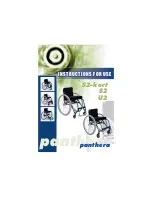
Instructions for use U2, S2, S2-short
Instructions for use U2, S2, S2-short
7
8
7) Position of the brakes, high brakes
See fi gure 7. The brakes should be adjusted so that they sink
into the tyre by about 4 mm when locked. This can be done
by loosening the front clamping bolt using cap key no. 10 and
the 4 mm socket head key, and then pushing the brake forward
along the seat tubing of the frame. Try out positioning and
when satisfi ed tighten the lock screw once again.
Figure 8.
Single-hand brake.
Figure 7.
High brakes.
Single hand brake (accessory)
This brake is assembled under the seat tubing
and can be adjusted in the same way as the
high brake. It is important to check that the
brakes are placed at the same distance on
both sides of the frame as shown in fi gure 8.
N.B! As the air pressure falls, the tyre beco-
mes worn, or if you change the type of tyre
the effect of the brakes will vary. You should
therefore check the position of the brakes in
these circumstances.
Figure 9.
Anti-tips.
Anti-tips (accessory)
When the anti-tips are folded out you can
adjust the distance from the ground by fi xing
the wheel tubing in any of the four positions
as shown in fi gure 9.
The anti-tips can be folded away under the
frame by pushing them down and twisting
them in under the seat. When you wish to
fold them out again, make sure that they
reengage into the lock tracks.
When learning how to drive on the rear
wheels you should have the anti-tips posi-
tioned to be able to tip the chair up into rear
wheel balance.
Maintenance
Your Panthera is constructed to be virtually maintenance free. A few parts do require
regular checking however. (Naturally you should clean and check the chair more often
if you use it in more extreme environments such as in sand or salt water.)
Once a month you should:
Wipe the chair chassis over with car shampoo or washing-up liquid and a damp
cloth. If very dirty you can use a degreasing agent. Lubricate all moveable parts
with a universal lubricant (5-56, WD-40) after cleaning.
Clean the caster fork casing (between the wheel and the fork). Hair and dust col-
lect here which can damage the bearing. Loosen the nut using key no. 10 while
holding the bolt with key no. 10. Remove the bolt and then the wheel. Clean the
washers between the wheel and the fork and wipe the outside of the wheel bearing
with a cloth. Drop some oil into each bearing. Reassemble the parts.
Lubricate the rear wheel axles. Remove the wheel and distribute some drops of
oil over the axle. You should do this more often if you drive in rain, sand, salt and
slush or if you rarely remove the wheels.
Pump up the tyres. The tyres can be pumped by screwing the top off the valve and
fi lling with air using an appropriate valve adapter. The tyre can take 8 kg of pres-
sure.
Check that all the screws and nuts are securely fastened.
Check that the chair has not been damaged. If damage has occurred, contact us
immediately at Panthera Production AB.
Twice a year you should:
Lubricate the ball bearings for the brakes with some drops of oil.
Lubricate the bearings in the joints of the backrest. Remove the nut using cap key
no. 10 and hold the bolt still with key no. 10. Lubricate the bearings with some
drops of oil.
Wash the seat upholstery, the back upholstery and the cushion cover in 40 degrees
machine wash when necessary.
Guarantee and lifetime
The life of a Panthera depends on how much wear and tear it is exposed to and how
thorough you are with maintenance.
Guarantee: We offer a seven year factory guarantee on the chassis. For other parts there
is a guarantee of 12 months.
Max. weight: 30, 33, 36, 39, 42 cm 100 kilos, 45 cm 125 kilos and for 50 cm 150 kilos.
•
•
•
•
•
•
•
•
•









